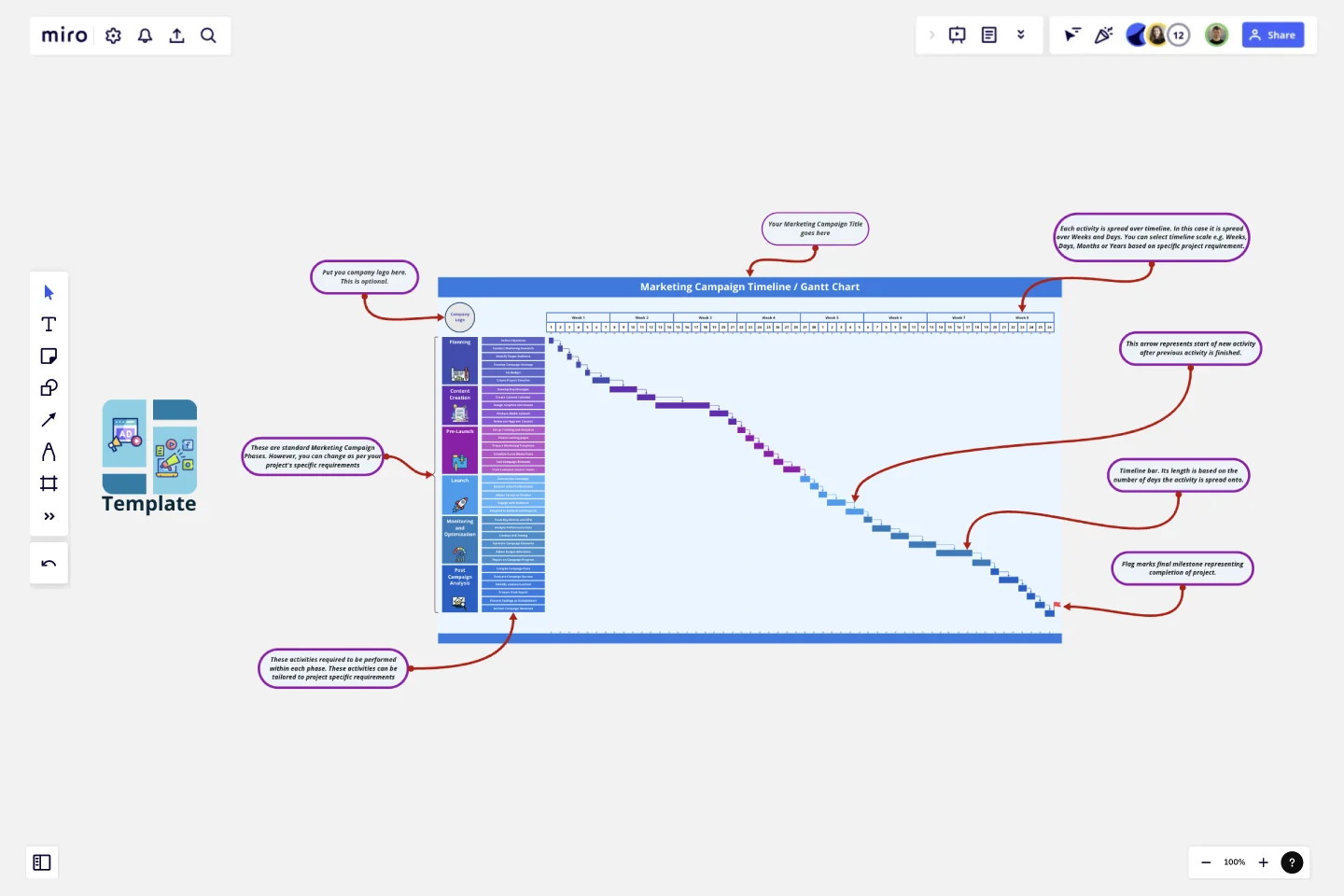Marketing Campaign Timeline
This Marketing Campaign Timeline/Gantt Chart template is meticulously designed to help you plan, execute, and analyze your marketing campaigns with precision and clarity.
The template is organized into six key stages: Planning, Content Creation, Pre-Launch, Launch, Monitoring & Optimization, and Post-Campaign Analysis. Each stage includes detailed sub-tasks to ensure a thorough and efficient campaign process. A filled example for a Social Media Marketing Campaign is provided to illustrate how to utilize the template effectively.
How to Use the Template
Review the Example: Start by examining the filled example for a Social Media Marketing Campaign to understand how each stage and sub-task is mapped out.
Customize for Your Campaign: Replace the example content with details specific to your marketing campaign. Adjust the stages, sub-tasks, and timelines according to your campaign’s needs.
Update Regularly: Keep the timeline updated with the latest progress and changes. Use the template to track each stage of the campaign and ensure all tasks are completed on time.
Communicate with the Team: Use the template to provide regular updates to your marketing team, ensuring everyone is informed about the status of the campaign and any adjustments that need to be made.
This template is a comprehensive tool designed to guide you through the entire marketing campaign lifecycle, ensuring a structured and effective approach to achieving your marketing goals.
This template was created by Khawaja Rizwan.
Get started with this template right now.
Kanban Framework Template
Works best for:
Kanban Boards, Agile Methodology, Agile Workflows
Optimized processes, improved flow, and increased value for your customers — that’s what the Kanban method can help you achieve. Based on a set of lean principles and practices (and created in the 1950s by a Toyota Automotive employee), Kanban helps your team reduce waste, address numerous other issues, and collaborate on fixing them together. You can use our simple Kanban template to both closely monitor the progress of all work and to display work to yourself and cross-functional partners, so that the behind-the-scenes nature of software is revealed.
Define Your Product's Target Audience
Works best for:
Product Management, Planning
Too broad an audience? Or trying to target too many audiences? This is a certain path to product failure.
One Page Product Strategy
Works best for:
Product Management, Planning
The One Page Product Strategy template condenses complex product strategies into concise, actionable plans. By providing a structured framework for outlining goals, target markets, and key initiatives, this template enables product teams to align on strategic objectives efficiently. With sections for defining value propositions, competitive differentiators, and success metrics, it facilitates strategic decision-making and execution. This template serves as a roadmap for driving product development efforts and achieving business objectives effectively.
Competitor Product Research
Works best for:
Product Management, Planning
The Competitor Product Research template assists product teams in analyzing competitor offerings and market landscapes effectively. By identifying competitor strengths, weaknesses, and market trends, this template enables teams to uncover insights and opportunities for differentiation. With sections for conducting feature comparisons, SWOT analysis, and market positioning assessments, it facilitates informed decision-making and strategic planning. This template serves as a valuable resource for gaining competitive intelligence and driving product innovation and differentiation.
Gantt Chart Project
Works best for:
Strategy, Planning
The Gantt Chart Project template is a versatile tool for managing various types of projects. It provides a clear visual timeline of your project's tasks, deadlines, and dependencies. Use it to plan, execute, and monitor your project's progress, ensuring all activities are aligned and on track. This template enhances team collaboration, improves time management, and helps address potential bottlenecks for successful outcomes.
Event Planning Timeline
Works best for:
Timeline
Organizing an event involves numerous tasks and tight deadlines. The Event Planning Timeline template simplifies this process. Use it to plan and track every aspect of your event, from initial brainstorming to final execution. Assign tasks, set deadlines, and monitor progress to ensure smooth operations. Whether for small gatherings or large conferences, this template helps manage logistics and coordination.
